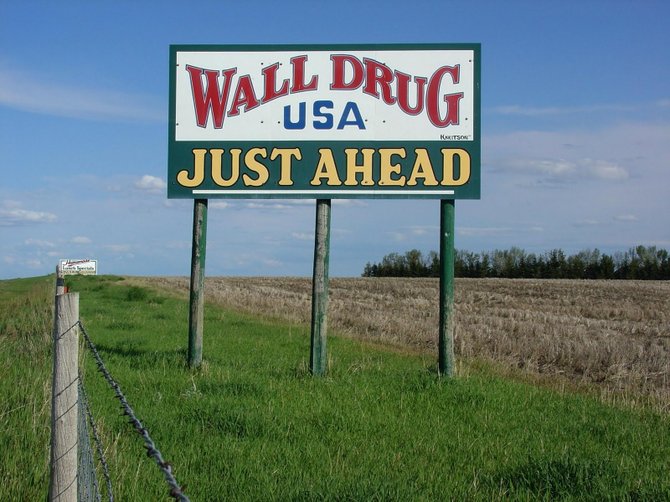 Facebook
Facebook
 X
X
 Instagram
Instagram
 TikTok
TikTok
 Youtube
Youtube

If you live in the United States, there’s most likely a Wal-Mart around the corner from your home: statistically, there are approximately 3,600 Wal-Mart stores in America. But there is only one Wall Drug, and it’s in the town of Wall, South Dakota.
As I drove across the country from Cleveland, Ohio, to San Diego, I passed through South Dakota in order to cross Mount Rushmore off of my travel bucket list. While driving past miles and miles of cornfields, my friend and I kept noticing these billboards for bizarre tourist traps, like Rapid City’s Reptile Gardens and Mitchell’s Corn Palace (which we imagined as a castle built entirely out of ears of corn).
These billboards came and went, but the ones for Wall Drug were especially persistent, beginning their repetition over 150 miles east of the town of Wall. At first, my friend and I laughed at these signs, which advertised everything from “Free Ice Water” to “Five-Cent Coffee” to a dinosaur backyard where you could “Do Lunch or Be Lunch.” I later learned that these Wall Drug signs can be found all over the globe, in places like England, Kenya, Afghanistan – even Antarctica.
In Neil Gaiman’s recent science fiction novel, American Gods, the mythical gods that still inhabit America use tourist attractions as gathering places for their meetings. If this were reality, Wall Drug would surely fit the bill, as it's indeed a bona fide preservation of Americana in the middle of the country. And in many ways, I believe it serves as a relic of a previous American lifestyle that still had room for community, family and generosity within its consumerism. Wall Drug’s signs offered “Free Coffee and Donuts for Veterans” and proclaimed “Kids Love Wall Drug!”
My friend and I eventually deemed Wall Drug as a worthy place for one of our pit stops on our long drive ending in Murdo, SD. We were not surprised by the hokey statues of reindeer or the one of a Tyrannosaurus Rex, borrowed from Universal Studios. But we were impressed by Wall Drug’s range of attractions, including a shooting range, diner-style food from several eras, a homemade ice cream shop, a cowboy bookstore, a church, and – yes, it was true – five-cent coffee.
In one sense, Wall Drug is just a warehouse of tchotchkes, knick-knacks and self-promoting souvenirs. In their largest shopping area, you could purchase personalized mini license plates, key chains and drink koozies all stamped with the Wall Drug label.
On the other hand, it represents a certain evolution. The South Dakota badlands, famous for the cowboy town Deadwood, used to be filled with buffalo, Native Americans and prairie schooners. Now, Wall Drug is what’s left of what used to be a wild territory, and its success can be partially attributed to its solitary, isolated nature.
While conserving certain traditional aspects of culture, Wall Drug shows that in America, many attractions entertain through imitation – not authenticity.


If you live in the United States, there’s most likely a Wal-Mart around the corner from your home: statistically, there are approximately 3,600 Wal-Mart stores in America. But there is only one Wall Drug, and it’s in the town of Wall, South Dakota.
As I drove across the country from Cleveland, Ohio, to San Diego, I passed through South Dakota in order to cross Mount Rushmore off of my travel bucket list. While driving past miles and miles of cornfields, my friend and I kept noticing these billboards for bizarre tourist traps, like Rapid City’s Reptile Gardens and Mitchell’s Corn Palace (which we imagined as a castle built entirely out of ears of corn).
These billboards came and went, but the ones for Wall Drug were especially persistent, beginning their repetition over 150 miles east of the town of Wall. At first, my friend and I laughed at these signs, which advertised everything from “Free Ice Water” to “Five-Cent Coffee” to a dinosaur backyard where you could “Do Lunch or Be Lunch.” I later learned that these Wall Drug signs can be found all over the globe, in places like England, Kenya, Afghanistan – even Antarctica.
In Neil Gaiman’s recent science fiction novel, American Gods, the mythical gods that still inhabit America use tourist attractions as gathering places for their meetings. If this were reality, Wall Drug would surely fit the bill, as it's indeed a bona fide preservation of Americana in the middle of the country. And in many ways, I believe it serves as a relic of a previous American lifestyle that still had room for community, family and generosity within its consumerism. Wall Drug’s signs offered “Free Coffee and Donuts for Veterans” and proclaimed “Kids Love Wall Drug!”
My friend and I eventually deemed Wall Drug as a worthy place for one of our pit stops on our long drive ending in Murdo, SD. We were not surprised by the hokey statues of reindeer or the one of a Tyrannosaurus Rex, borrowed from Universal Studios. But we were impressed by Wall Drug’s range of attractions, including a shooting range, diner-style food from several eras, a homemade ice cream shop, a cowboy bookstore, a church, and – yes, it was true – five-cent coffee.
In one sense, Wall Drug is just a warehouse of tchotchkes, knick-knacks and self-promoting souvenirs. In their largest shopping area, you could purchase personalized mini license plates, key chains and drink koozies all stamped with the Wall Drug label.
On the other hand, it represents a certain evolution. The South Dakota badlands, famous for the cowboy town Deadwood, used to be filled with buffalo, Native Americans and prairie schooners. Now, Wall Drug is what’s left of what used to be a wild territory, and its success can be partially attributed to its solitary, isolated nature.
While conserving certain traditional aspects of culture, Wall Drug shows that in America, many attractions entertain through imitation – not authenticity.
Comments